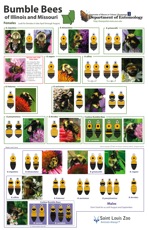 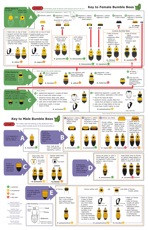 Field Guide to the Bumble Bees of Illinois and Missouri |
|
One
of several lines of research in my lab applies molecular phylogenetics
to questions of social evolution in bees. A second line focuses on the
evolution of color pattern in bumble bees, which have evolved striking
Muellerian mimicry patterns worldwide. A third line is developing new
protocols to assess the status of recent population decline in North
American bumble bees, including the use of natural history museum
collections to reconstruct the genetic structure of historical
populations for comparison with current populations and development of
genomic markers for application to questions of temporal influences on
population changes from recent anthropogenic factors to ancient
climatic events.
|
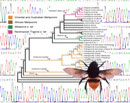
Molecular Systematics
|
|
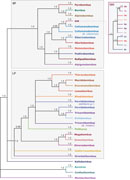
Bombus phylogeny
|
We
use molecular data to reconstruct phylogenies of bees that belong to
the corbiculate clade within the family Apidae (subfamily Apinae),
including bumble bees (Bombini; link to pdf of the Bombus tree), stingless bees (Meliponini), and orchid bees (Euglossini);
a fourth corbiculate tribe comprises the honey bees (Apini). We have
inferred individual phylogenies of these tribes. These phylogenies
allow rigorous tests of evolutionary hypotheses and provide a critical
framework for predicting environmental
influences on various phenotypes, including color pattern, nest
architecture and colony-level behavior, such as aggression, division of
labor and communication.
|
|
The
recently completed phylogeny of bumble bees is the foundation for
expanding our research into a new area, applying the tools of
evolutionary developmental genetics to examine evolution of the
extraordinary color pattern complexes (mimicry rings) in bumble bees (developing research directions).
Currently, we are identifying the pigments found in the variously
colored hairs of bumble bees, which will allow us to target candidate
genes as factors governing the spatial and temporal expression patterns
of hair pigments. We are also using the comparative method to examine
the degree to which phylogeny explains bumble bee color patterns and
the rates at which different body regions change color.
|
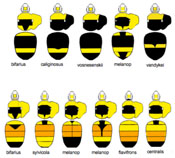
Color pattern
|
|
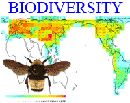
Biodiversity and Conservation of Bumble bees
|
My
lab is part of a multi-team research effort to understand the causes of
decline in several species of North American bumble bees (NRI).
At the moment, there appears to be a phylogenetic component to the
decline, which is most evident among species within the subgenera Bombus sensu stricto and Thoracobombus (pensylvanicus-group).
The team is examining multiple target species of bumble bees across the
U.S., collecting data on current population status, genetic population
structure and pathogen loads. We are also generating microsatellite
data from our large museum collections of Bombus, using
non-destructive sampling methods to assess historical population
structure, which we will compare with current population data. See highlights from our first summer survey (2008).
|
|
My
behavioral research focuses on comparative studies of tropical bumble
bees, using the Bombus phylogeny for insights into species
relationships and comparative studies of behavioral modifications
associated with living in tropical wet forests. Behavioral features
include nest architecture and division of labor. Studies of recruitment communication (Dornhaus & Cameron; Nieh et al.) in tropical bumble bees could shed light on the roles of adaptation and phylogenetic history in their social evolution.
|
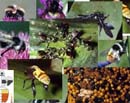
Behavior and Ecology
|
|
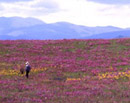
Field Work
|
Much
of my field research takes place in the Amazon Basin of South America
and, more recently, in Mexico. My students and I have made
expeditions to Himalayan China, Burma, Malaysia, India, Turkey and
alpine regions of Europe to collect bumble bees. Stingless bee
expeditions have been made to South America and Malaysia.
|
|
In a collaborative effort, UIUC faculty and graduate students have completed an online database of Hymenoptera (ants, bees, sawflies, and wasps) within the Illinois Natural History Survey (INHS). A total of 300,000 Hymenoptera records have been entered and georeferenced for all U.S. localities. The bumble bee (Bombus)
collection, including the well known Frison collection, is one of the
largest repositories of bumble bees nationally and internationally, and
there are many other well represented groups of bees. The Survey has
been home to leading figures in hymenopteran taxonomy, hence the
collections are generally well-curated and contain valuable associated
information, such as parasitoid/host and bee/pollen-source records.
|

Hymenoptera Database
|
|



